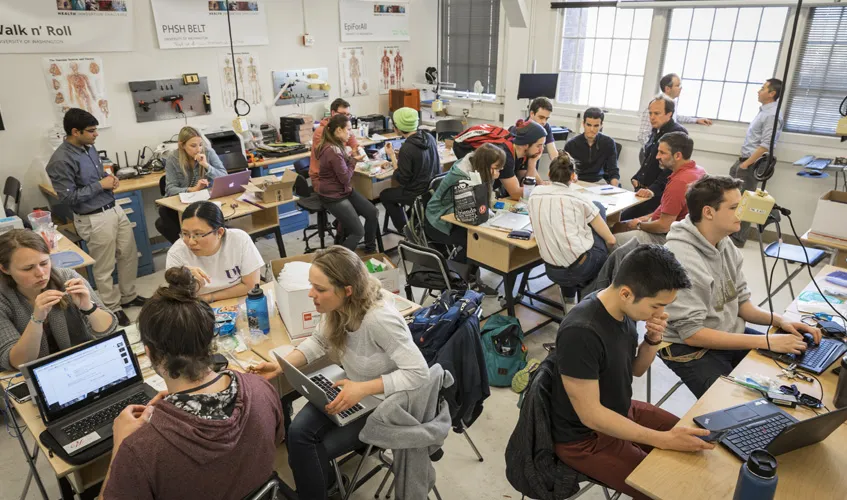
Engineering Innovation in Health students at work. Photo by Mark Stone / University of Washington.
EIH by the numbers, 2013–2017
| 200+ | Students enrolled since EIH began in 2013 |
| 100+ | Clinical partners from institutions such as UW School of Medicine, UW School of Dentistry, Seattle Children’s Hospital, UW School of Nursing and Providence Health & Services |
| 80/20 | percentages of undergraduate and graduate students who participate in EIH |
| 75 | Total projects introduced through EIH |
| 10+ | Provisional patents for devices that emerged through EIH |
| 9 | UW departments represented through student involvement |
| 3 | Projects in early stage commercialization |
Never before have we faced more complex health care challenges — or more exciting opportunities — to save more lives, reduce costs and improve care through cutting-edge technology. Through cross-disciplinary collaboration and entrepreneurship, ME’s Engineering Innovation in Health (EIH) program provides a framework for engineering students and faculty to partner with clinicians and develop affordable solutions to today’s pressing health needs.
“We started EIH in 2013 because we saw the disconnect between engineers and clinicians as directly impacting health care costs and innovations,” says ME professor and chair Per Reinhall, who worked closely with ME associate professor Jonathan Posner and members of the ME’s external advisory board to develop the program.
“We all agreed that this was an opportunity for a change in the culture,” adds Posner. “EIH’s goal is to prepare the next generation of students and faculty in medical device development and innovation while establishing a multidisciplinary culture of engineers and health practitioners.”
Through EIH, students are coached in advancing their devices through initial stages of design and prototyping to generate patents, data for publications and grant applications, and — ultimately — to introduce their innovations to market.
Collaborations across industry and campus are central to EIH. Doctors, nurses, physical therapists, dentists and pharmacists present EIH with challenges they face in practice. A review committee assesses and selects projects that seem like a good match for the program’s interdisciplinary student teams.
Projects and deliverables are managed within a year-long design course sequence: fall quarter is dedicated to deepening an understanding of the clinical need and device design, winter and spring to prototyping and evaluation. Projects are assessed at the end of fall quarter; those that demonstrate the most potential are encouraged to move forward through winter and spring quarters for full development.
Clinician-faculty-student teams work together from beginning to end and submit their devices to UW CoMotion for U.S. patent consideration. Once they complete the program, EIH teams may continue to refine their devices and move toward commercialization.
Here we highlight five projects that originated through EIH and are still building momentum.
EpiForAll
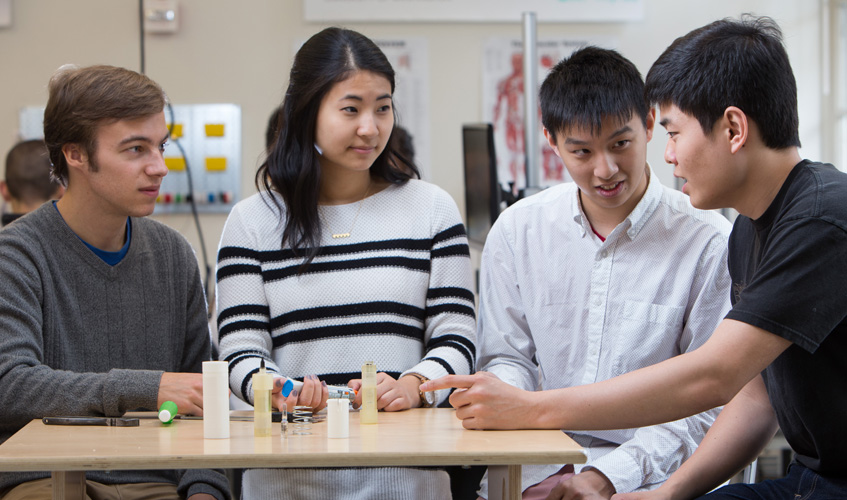 Photo by Matt Hagen.
Photo by Matt Hagen.
An affordable alternative to the epinephrine auto-injectors currently on the market, these devices are used to treat anaphylaxis, a potentially life-threatening allergic reaction. This team has developed a version for low-resource communities worldwide that utilizes readily available, low cost epinephrine ampules.
EpiForAll placed first in the UW Buerk Center for Entrepreneurship’s Hollomon Health Innovation Challenge (HIC) this year and fourth in the Center’s Business Plan Competition. Teammates are working with UW’s Entrepreneurial Law Clinic to form a company and have filed for a utility patent through UW CoMotion.
PlayGait™
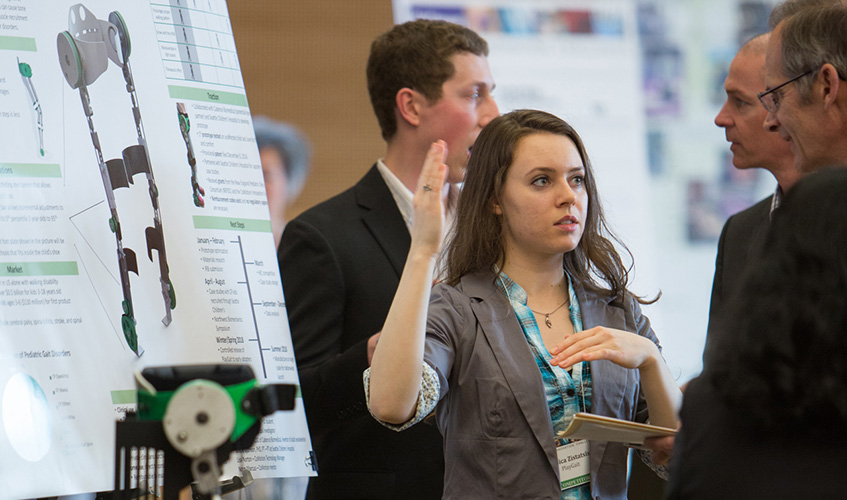 Photo by Matt Hagen, courtesy of the Buerk Center for Entrepreneurship.
Photo by Matt Hagen, courtesy of the Buerk Center for Entrepreneurship.
Children with gait disorders get limited walking practice with the correct gait pattern outside of physical therapy, which can slow their rehabilitation rate. PlayGait™ is a pediatric exoskeleton that helps children with gait disorders walk more, so they can build muscle strength and increase independent mobility.
Since completing EIH, the team has received $95,000 in grants to support research and development and has filed a provisional patent through UW CoMotion. Team members won third place at this year’s HIC and competed in the Buerk Center’s Business Plan Competition. They are currently preparing to test with patients and are planning for a controlled initial product release in 2018.
MistEase
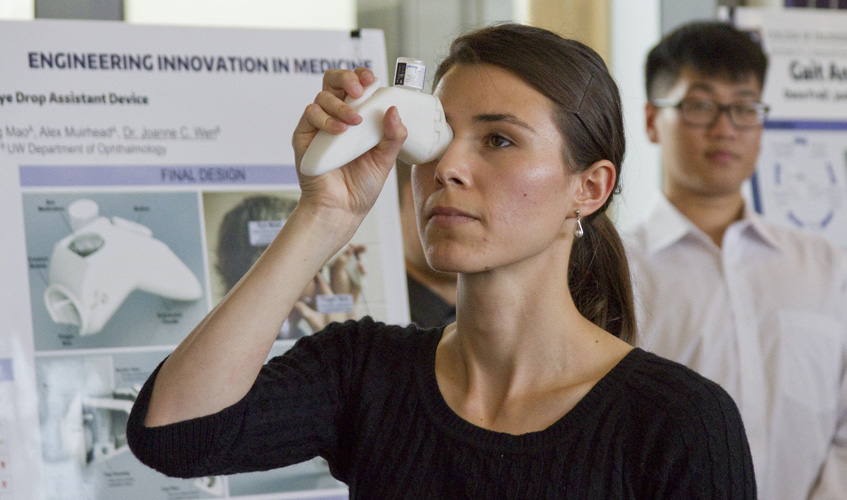 Photo by Connie Wellnitz.
Photo by Connie Wellnitz.
Glaucoma is the second leading cause of irreversible blindness, and elderly patients often find it difficult to take their eye medications due to limitations in dexterity and vision. MistEase is a device that makes it easier for elderly people to administer their eye drops.
MistEase has been approved for clinical study and is being tested with patients.
Quinton PHSH (Parastomal Hernia Support Harness)
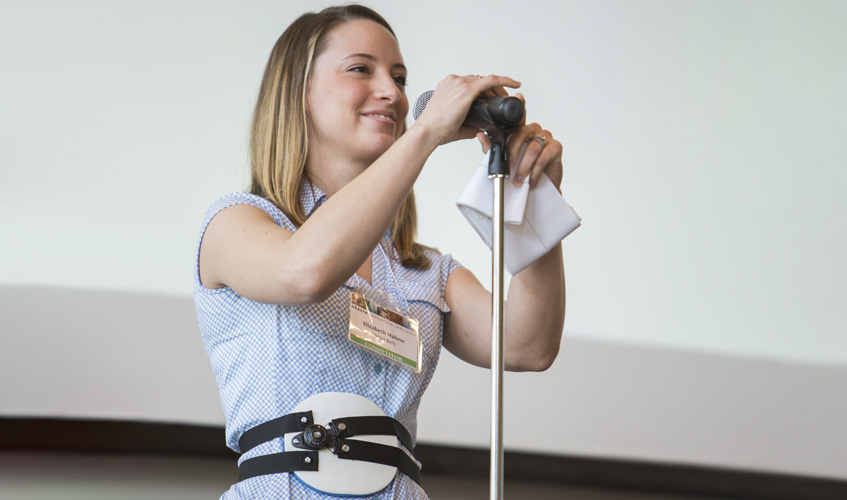 Photo by Matt Hagen, courtesy of the Buerk Center for Entrepreneurship.
Photo by Matt Hagen, courtesy of the Buerk Center for Entrepreneurship.
Patients who have undergone gastrointestinal stoma surgery are at high risk for developing hernias. They can reduce this risk by wearing specially designed support belts, but those currently on the market tend to be uncomfortable and difficult to wear. Building upon work of noted UW bioengineering pioneer and ME alumnus Wayne Quinton, BSME ’58, who began generating ideas for this device before he died in 2015, the team has designed an easy-to-wear support harness that stays in place as its user moves throughout the day.
The team has filed for a provisional patent and is planning to test with patients through a clinical study at UW Medicine.
ACBI (Automated Continuous Bladder Irrigation)
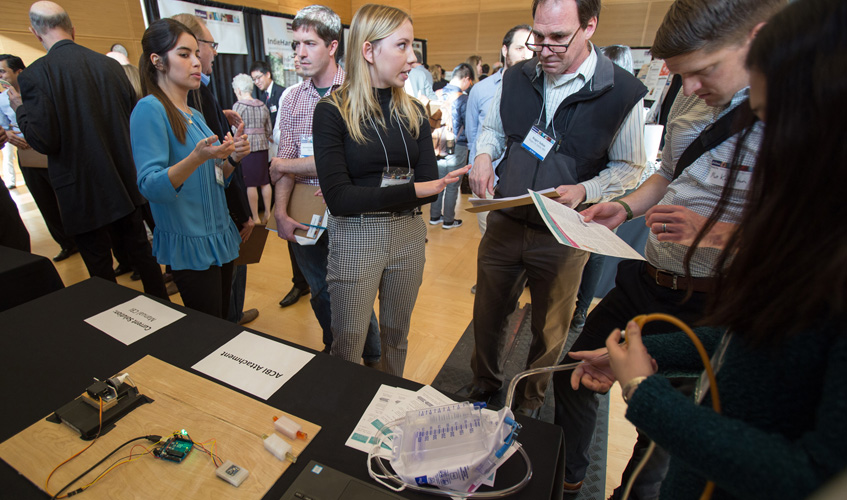 Photo by Matt Hagen, courtesy of the Buerk Center for Entrepreneurship.
Photo by Matt Hagen, courtesy of the Buerk Center for Entrepreneurship.
Patients who undergo prostate or bladder surgery may develop blood in their urine. If untreated, a blood clot may form, making it difficult or, in some cases, impossible for patients to urinate. Continuous Bladder Irrigation — the current process to keep the bladder free of blood clots — is labor-and time-intensive. This team’s device automates the process of managing saline flow, assessing blood levels and alerting nurses of irregularities.
Team members continue to work on developing their prototype. They are looking for commercialization partners and funding opportunities to support their work.
Originally published June 26, 2017